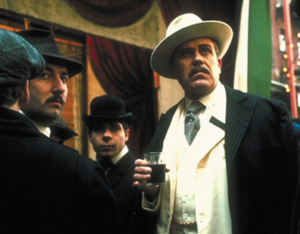Its rare to find a sequel that surpasses the original, let alone one that is universally considered superior. Such is the case with the iconic Francis Ford Coppola film, “The Godfather: Part II.”
“The Godfather: Part II” was released in 1974, and serves as a followup to the 1972 original movie. Like the original, the film is based off the writings of Mario Puzo, who penned ‘The Godfather’ novel in 1969. The first movie would win 3 Academy Awards, a feat shattered by Part II with its 11 nominations and 6 wins.
“The Godfather: Part II” is thoroughly unique in its presentation, serving chronologically as both a sequel and a prequel to the first movie, with two simultaneous storylines separated by 40 years of time juxtaposed throughout.
“The Godfather: Part II” presents itself with the same dark tones as the original, with a lauded and haunting score that won an Academy Award, a bevy of sinister characters, and enough bloodshed to permanently cement its place in the archives of mob movie history.
I loved the innovative format used by Francis Ford Coppola, who would produce, direct, and write the picture, which follows the paths of a young Vito Corleone in the decades leading up to his becoming the Godfather of the Corleone family, and youngest son Michael as he continues to operate the family’s day business.

In a summery Italian countryside in 1901, mafioso Don Ciccio wipes out Vito’s entire family. Marked for death, the 9 year old boards a steamer with thousands of other impoverished immigrants bound for America. The arrival scene itself is marvelous as we watch through Vito’s eyes a ship full of immigrants reacting in awe to the site of the Statue of Liberty and the hopeful promise of a better life.
In present day (1958) Michael Corleone (Al Pacino) is in the process of continuing the expansion of his family business. As he rubs elbows with powerful politicians and furthers the casino operations, he is also faced with family issues and a growing rift with his pregnant wife (Diane Keaton). “In 5 years the Corleone family will be completely legitimate.” She scolds him in an early scene, reminding him of a promise he made to her. “That was 7 years ago.”
With its stunning visual presentation, the movie continues to jump back and forth in time; taking the viewer on a ride that displays the mesmerizing early years of New York City as young Vito (Robert De Niro) struggles to survive in an Italian ghetto, eventually rising up to being a respected and feared man on the streets.
Robert De Niro is one of my favorite actors and its safe to say I loved the prequel scenes that depicted his rise to power as Vito Corleone a little better than the present day followup story line involving Michael. De Niro is perfect in a role he’s perfected over the years, and there’s an added bonus in seeing him dressed in tattered garb and classic fedora in the dust filled streets of old New York.
In 1958, Michael’s escapades see a bloody rivalry develop with Jewish mobster Hyman Roth (Lee Strasberg). Aware of the treacherous nature of the rival, Michael maintains a professional kinship with the iconic Godfather philosophy of keeping friends close and enemies closer.
“The Godfather: Part II” has a phenomenal setting, with early 1900s New York City brought to life in such a way you’ll wish you had been a part of its charm. We also get great glimpses of 50s era Miami, Las Vegas, and Cuba, as well as some scenes in the breathtaking hills of Sicily.
While its helpful to have watched the original movie, the sequel stands alone in terms of its scope and layout. The concept of a prequel within the walls of a sequel is a thing of sheer beauty, and anyone watching will truly appreciate the innovation of this dynamic.
The supporting cast is immense, and consists of two greats, Robert Duvall and John Cazale, both reprising roles from the original. Duvall portrays Tom Hagen, the Corleone family consigliere, a man who is always steadfast in serving Michael with whatever business needs to be taken care of. The late John Cazale is remarkable as elder brother Fredo, who we see take on more of a role in the family business, for better and for worse.
My issue with the movie is its daunting run time. At 3:30 its obvious Francis Ford Coppola avoids an editing room like the plague. While holding close to the standards of the novel, its unnecessary to include every single page and character from within the covers of a book. There are a handful of really great scenes but the pathway to each is a slow and arduous one. The movie is so well made as a whole it would be that much better if it were trimmed down just a touch. Ultimately it’s a brilliant work of art as far as film goes, but because of its length its not something you would find yourself sitting down to watch again and again.
“The Godfather: Part II” is an iconic movie, one that exceeded expectations and lives up to its hype of outdoing the original. Its a true example of how brilliant a film can be when made the right way.
by – Matt Christopher